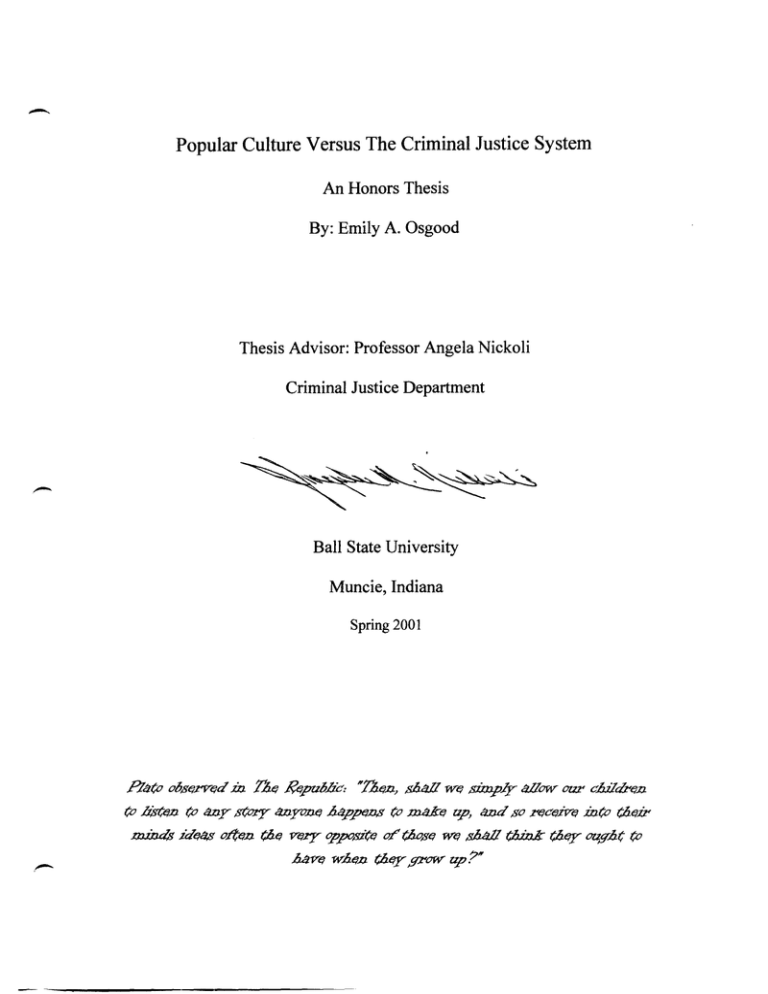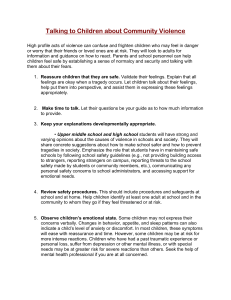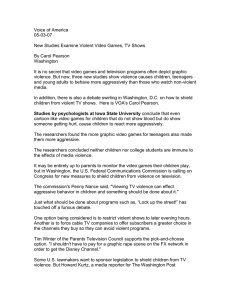- Popular Culture Versus The Criminal Justice System
advertisement

Popular Culture Versus The Criminal Justice System An Honors Thesis By: Emily A. Osgood Thesis Advisor: Professor Angela Nickoli Criminal Justice Department Ball State University Muncie, Indiana Spring 2001 net Plato oose:nre:d m J?qmo/:ic: "ntW-~ s/UJ.ll we: simp./y allow OW:' c.6:ildre:n to /:is(e:n to My ~ Myv.r.uJ hllppw8 to make: up~ a.v.d so rt;ce:irre: mto the:ir m l.tuls id~ o/te:n the: ve:q opposite: 0/ those: we: s/UJ.ll t;/Ji.1J.k thqr ought to hIlve: whe:n thqr pow up 7" C " I, 1 I' - Abstract The purpose of this paper is to examine the controversial Issue of pop culture (i.e. television, movies, news media, and video games) and it's effects on children. It is widely theorized that aggressive behavior in young children is the result of repeated exposure to unnecessary violence in various forms of media. This paper defines popular culture and looks at psychological and sociological research that has taken place over the past forty years. It also explores several crimes in order to determine whether violence in the media had an effect on the commission of that crime. Acknowledgements Many thanks are due to Professor Angela Nickoli, my thesis advisor, for her role in this - project. Having worked together on a different version of this paper, she graciously agreed to continue working with me for the sake of this thesis. Her editorial comments and advice were instrumental in the successful completion ofthis project. Thank you Dr. Nickoli for your willingness to continue to serve as my advisor and for your help through the different stages of this process. - Introduction In 1977, Ronny Zamora, a 15-year-old Costa Rican immigrant living in New York City was tried for the murder of his eighty-two year old neighbor. Zamora shot the woman after she caught him robbing her home. His lawyer tried a new approach for his defense and argued that Zamora couldn't be held responsible for his actions because he was the victim of insanity that stemmed from being "under the influence of prolonged, intense, involuntary, subliminal television intoxication" (Bender 1999, p. 16). From the time he was a young child, Zamora had been left home alone for countless hours while his mother worked - his babysitter being the television. Experts testified that television had given the boy distorted ideas about the nature of violence and had conditioned him to react the way he did when his neighbor caught him. They said the shooting "was a conditioned reflex based on his exposure to violent television" (Bender - 1999, p. 16). The prosecution produced its own experts to testify that the shows Zamora watched should have taught him that killing was wrong and that criminals were usually punished. They maintained that Zamora had apparently learned those lessons since he muffled the gunshot with a pillow and tried to hide and destroy evidence. The jury ultimately found Zamora guilty. The above-mentioned case was the first lawsuit against television networks for inciting violence in children and even though it was lost, it brought the issue of media and violence to the attention of the American public (Bender 1999). While few would excuse the actions of Ronny Zamora, many researchers have concluded that television and movies, as forms of popular culture, do affect children by making them more aggressive and less sensitive. Others believe that there is no correlation between popular culture and real life violence. The following will briefly define and examine popular culture and the issues surrounding this debate. First, it is - important to define "popular culture". 1 - Defining Popular Culture Popular culture has been a part of American society for many years. In the simplest terms, popular culture is defined as "objects of creative expression, entertainment, and style designed to appeal to society as a whole" (Microsoft Encarta Encyclopedia 2000). Throughout history, researchers have argued about whether the effects of various forms of popular culture were harmful. During the nineteenth century, educators warned about the effects of dime store novels and newspaper crime stories on the young. In the early twentieth century, motion pictures and radio were both viewed as significant social threats. Today, concerns are expressed over violence on television and in video games. Throughout the technological evolution, some fundamental questions have remained the same: Do depictions of violence in the media somehow contribute to real life violence? Are viewers of such violence encouraged to commit - acts of violence themselves? With this definition of "popular culture" in context, it is important to examine the criticism surrounding "popular culture" and its link to the criminal justice system, primarily crime. Popular Culture v. The Criminal Justice System: Television Television was introduced to the American public at the New York World's Fair in 1939. Author, E.B, White wrote, with uncanny clairvoyance: I believe television is going to be the test of our modern world, and in this new opportunity to see beyond the range of our vision, we shall discover either a new and unbearable disturbance of the general peace or a saving radiance in the sky. We shall stand or fall by television - of that I am quite sure (White, 1938). By the early 1950s, only a quarter of American households had television sets and the programs - were designed specifically for intellectual stimulation. This quality programming failed to keep 2 - viewers interested and families were turning off the TV set in favor of conversation, radio, and visiting with the neighbors. Enter the first action-packed shows - The Untouchables and Gunsmoke. These shows caught the American public's attention and networks found that the more gratuitous the violence, the more viewers would watch. This worked until the amount of violence on screen reached comparable levels to the amount seen in every day life - the novelty had worn off and the levels on TV had to be increased to keep the public interested (Grossman & DeGaetano, 1999). There are a couple of reasons for the focus on television as a cause of violence. It is pervasive: 98% of American households have at least one television set. It is also heavily watched: Studies have estimated that children spend twenty-two to twenty-eight hours a week watching television (Levine, 1996). It is well known that television is a strong force in the - average American's life - one in four say they wouldn't surrender their TV's for a million dollars (TV Guide, 1992). One of the earliest studies focusing on media violence and children came out of Stanford University in the 1960's. Psychologist Albert Bandura examined the circumstances under which children became more aggressive by observing aggression (Bandura, 1965). He divided nursery school children into three groups. All of the children were put into a room filled with attractive toys. One group was only observed in this setting, while the second was shown a film sequence on a television that involved an adult and an inflatable doll. The adult walked up to the doll and ordered it out of the way, when the doll didn't move the adult sat on the doll, punched it, kicked it, and threw it. The third group watched this sequence performed live. The three groups were then placed back into a room filled with toys. Bandura found that the children who viewed the 3 - program were more likely to display aggressive behavior towards the doll than those children who had not watched the sequence (Bandura, 1965). Later, researchers like Bandura, began studies to determine whether violent entertainment promotes criminal violence and what the effect is on the impressionable minds of children. As discussed earlier and found in the Bandura study, the "monkey see, monkey do" attitude can be applied to our children - they imitate the behavior they see. In 1986, Leonard Eron and L. Rowell Huesmann identified three psychological processes through which exposing a child to excessive media violence can encourage aggressive behavior (Huesmann, 1986, p.127). Through the same observational processes that children learn cognitive and social skills, by imitating parents, siblings, peers, and others, they also learn aggression. Therefore, the more violence a child is exposed to, the more accepting they become of aggressive behavior and the - more prone they are to commit violent acts themselves (Huesmann, 1986, p.130). Consequently, there is also an attitude change; the more TV a child watches, the more accepting the child becomes of aggressive behavior. The third finding was that social behavior is controlled to a great extent by cognitive scripts and strategies that have been stored in memory and are used as guides for behavior. Television shows can be a source of such scripts. A child who repeatedly watches TV characters behaving in a violent way may store this as "script" to be used when facing similar situations (Huesmann, 1986, p.134). There are many reported cases where individuals were influenced by the media or copied what they saw on television. Pro Wrestling is rapidly becoming one of the most popular forms of sports entertainment. What the pros do in primetime, thousands of teenagers and young children are emulating in their backyards, with sometimes-tragic results. A twenty-four-year-old babysitter in Warner Robbins, Georgia put on a pay per view wrestling video for her six charges 4 _ left them alone - only to find that a four-year-old stomped an infant to death copying a move he had just seen a wrestler do in the ring. In Yakima, Washington, twelve-year-old Jason Whala performed a crowd-pleasing maneuver called the "jackknife power bomb" on his 19-month-old cousin. The child was killed and Jason Whala became the youngest person in Washington to be charged with murder. Thirteen-year-old Lionel Tate is also facing murder charges for killing six-year-old Tiffany Eunick. Eunick died from injuries sustained when Tate wrapped her in a bear hug, dropped her on a table and swung her into a railing. (Wrestling with Death, 2000) The mid 80's brought about several studies that reinforced the notion that violence on television affected children. In 1984, Eron and Huesmann concluded a 22- year study that tracked 875 boys and girls from ages eight to thirty (Eron & Huesmann, 1984). Taking into account their baseline aggressiveness, intelligence, and socioeconomic conditions, they found - that those who watched more violent television as children were more likely to commit serious crimes as adults. They further observed second-generation effects: those who watched more violence as children were more abusive toward spouses and punished their children more severely than those parents who watched less television as children. (Eron & Huesmann, 1986, p. 8). In 1992, Eron told the U.S. Senate Committee on Governmental Affairs: There can no longer be any doubt that heavy exposure to television violence is one of the causes of aggressive behavior, crime and violence in society. The evidence comes from both the laboratory and real-life studies. Television violence affects youngsters of all ages, of both genders, at all socio-economic levels and all levels of intelligence. The effect is not limited to children who are already disposed to being aggressive and is not restricted to this country (Eron, - Congressional Record, 1992). 5 _ Milavsky, who followed several hundred children age's seven to twelve for three years, published another important longitudinal study in 1982. He reports that initial correlations between exposure to violent media at the beginning of the study and later aggressiveness turned out to be small and statistically insignificant after controlling for social and familial factors, as well as past levels of aggressive behavior. Milavsky concluded that the results failed to support the hypothesis that exposure to media violence causes aggression in children (Milavsky, 1982). Eron and Huesmann viewed his results in a somewhat different light by focusing on the positive (albeit insignificant) statistical relationships between exposure to media violence and subsequent aggression as being at least consistent with the causal hypothesis. Huesmann wrote, " ... the results of the Milavsky study are not very different from those of other recent field studies. It is primarily Milavsky's interpretation of the findings that is different" (Eron & Huesmann, 1986, p. - 6-7). Dr. Thomas Cook (1983) reanalyzed Milavsky's study and came a similar conclusion that there was a relationship between media violence and aggression in the data and that it had been underestimated. Many researchers believe that it was more than coincidental that this study was funded by NBC. (Hattemer & Showers, 1993, p. 131) A 1986 study by researchers from the University of British Colombia explored the effects of introducing television to a rural community they dubbed Notel, for "No Television" (Williams, 1986). They studied both children and adults before the introduction of television into their environment and two years after. These results were compared with those from two other communities with television. Both children and adults in Notel showed a significant increase in physical and verbal aggression after two years, and they used aggressive behavior more often as an acceptable way of achieving their goals (Williams, 1986). 6 - The effects of television were reportedly higher in young children than in older children and adults. Forty-five first and second graders in Notel, as well as the two other communities, were studied during times of free play and measured their physical aggression. The same children were studied two years after television was brought into Notel. To prevent bias in the data, the research assistants observing the children were not told the purpose for the data. An entirely new set of research assistants were used in the observations the second time, so they wouldn't be influenced by some recollection of a child and their behavior two years earlier. The rates of physical aggression in the children from the two control communities did not change, but there was a 160% increase in the rates of the Notel children (Williams 1986). Perhaps the most harmful findings that the media does have an impact on violence did not come from a study on television. Looking at the murder rate in the United States, Epidemiologist Dr. Brandon Centerwall found that it had doubled from the 1950s and set out to discover why. He considered every possibility that could reasonably be the cause, including changes in economic conditions, the effects of the baby boom, trends in alcohol abuse and capital punishment, changes in the availability of firearms, and television. No candidate was considered more likely to be the cause than any other. Research over the next seven years consisted of gathering statistical data and testing each of the various factors to try and establish a link between television and the rising levels of violence. One by one each of the candidates were eliminated, all except for television. It held on through rigorous phases of testing and proved to be the only candidate to appear to have a causal relationship with the doubling murder rate. Dr. Centerwall surprised the nation by stating in 1992 "if television technology had never been developed, there would today be 10,000 fewer murders each year in the United States, 70,000 - fewer rapes, and 700,000 fewer injurious assaults" (Centerwall, 1992, p. 3061). 7 - Popular Culture v. The Criminal Justice System: Movies Similar to criticisms surrounding television, movies, as forms of popular culture, have been central aspects of the "blame game". When a crime has been committed with elements similar to a popular movie, society turns its focus to Hollywood for an explanation as to why the crime occurred. In May 1999, President Clinton held a session on Children, Violence and Responsibility, which was attended by members of Congress, religious leaders, activists and representatives from the entertainment industry. He requested that The Federal Trade Commission and The Department of Justice undertake a study of whether the movie, music recording, and computer and video game industries market and advertise products with violent content to a younger audience. He raised two specific questions: Do the industries promote products they themselves acknowledge warrant parental caution in venues where children make - up a substantial percentage of the audience? And are these advertisements intended to attract children and teenagers? The answer to both questions was a resounding "Yes!" (FTC Report, 2000): Although the motion picture, music recording and electronic game industries have taken steps to identify content that may not be appropriate for children, companies in those industries routinely target children under 17 as the audience for movies, music and games that their own rating or labeling systems say are inappropriate for children or warrant parental caution due to their violent content. Moreover, children under 17 frequently are able to buy tickets to R-rated movies without being accompanied by an adult and can easily purchase music recordings and electronic games that have a parental advisory label or are restricted to an older - audience" (FTC Report, 2000, p.6). 8 - As stated in the previous report, the primary target audiences for many in the entertainment industry are children under the ages of 17. Whether or not movies are a contributing factor to crime is a highly debatable issue, however, to fully understand this debate, it becomes important to analyze examples used within this debate. In 1915, The Birth ofa Nation was released to the American public. Scores of Americans watched as the members of the Ku Klux Klan were elevated to the status of "hero", saving their communities from the evils of the Negroes. As a result of the release of the movie, the Klan was reborn with an increase in membership (Atkinson, 1999). After the release of Stanley Kubrick's film A Clockwork Orange in England, rapists began to reenact scenes from the popular movie (Atkinson 1999). The movie The Deerhunter, released in the late 1970s, contained a very graphic portrayal of Russian roulette. In the months that followed the release, there were - numerous reports of individuals acting out that scene in which twenty-eight incidents ended in death. (Hattemer & Showers, 1993, p. 130) In 1985, a domestic violence film called The Burning Bed told the story of how a battered woman killed her husband by dousing him in gasoline while he slept and setting the mattress on fire. Only hours after that movie was televised, a distraught husband in Milwaukee poured gasoline over his wife and set her mattress on fire (Hattemer & Showers, 1993, p. 132). The popular movie Thelma and Louise, the story of best friends who run short on cash, hold up a liquor store and go on a crime spree, inspired two women who needed money while on vacation to commit their own similar robbery. (Hattemer & Showers, 1993, p. 134) Nineteenyear-old Mark Branch stabbed to death a female college student and then killed himself. His room was found to contain 90 horror movies and the machete and goalie mask made famous by the Friday the 13th film series. 9 - A key point is that a correlation between a certain violent motion picture or television show and a particular crime does not prove one caused the other. For example, instead of being inspired by Friday the 1fh to commit murder, Mark Branch could have been drawn to watch the series because he was a violent person by nature (Bender 1999, p. 14). Within the past ten years, we have seen movies contain more violence than ever before. Because of this, the motion picture industry has come under fire by critics and thrust into the courtroom by victims of crime. For a crime spree that lasted two days and resulted in two victims, Sarah Edmondson, 18, and Ben Darras, 17, received lengthy prison sentences. The preface to their journey: the repeated viewing of Oliver Stone's Natural Born Killers while dropping acid (Atkinson, 1999). Surviving family members of the victims filed a lawsuit against ,- both offenders, their parents, Oliver Stone, and Time Warner (Atkinson, 1999). Lawyers on behalf of the plaintiffs stated that "Stone should have known that the movie might incite such violence" referring to a quote by Stone in 1996 in which he said: "The most pacifistic people in the world said they came out of this movie and wanted to kill somebody." (Aynesworth, 1999, p.39). A more recent example includes an incident that occurred in 1995. Two children in New York City set fire to a subway token booth by spraying a flammable substance through the opening for change and tokens. The booth exploded and the subway attendant subsequently died because of the burns he received. This was only one of many similar incidents that bore a striking resemblance to a scene from the then recently released movie, Money Train (Murray, 1997). Even more recently, we have seen criticism surrounding the movie The Matrix and the tragedy that occurred at Colombine High School. 10 While the National Rifle Association asserts that "guns don't kill people, people kill people", they do so with guns. Similarly, we can say that television doesn't kill people, but it does have an influence on aggressive behavior. Acts of violence on television and in movies can't make a child commit a crime, but they can provide ideas for a child with other social and psychological problems and push that child into committing an act of violence rather than just thinking about it. According to L. Rowell Huesmann, Professor at the University of Michigan and an expert on the issue of media violence and aggression, a relationship does exist between media violence and aggression in children. Popular Culture v. The Criminal Justice System: News Media In addition to television and movies, the news media can have a big impact on children. "In 1993, 1994, 1995 and 1997, crime stories ranked first among network stories. In local - markets, crime stories consume one quarter to one third of total news time" (Doi, 1998 p. 35). The list of graphic and upsetting news stories from the past decade goes on and on: the Rodney King beating, the Oklahoma City bombing, recent school shootings, and countless natural disasters, plane crashes, murders and child molestations. The coverage of the school shooting in Littleton, Colorado has critics wondering about the ethics of TV news. Millions watched as the incident was still unfolding. Viewers saw SWAT teams moving in, the rescue of an injured student from a second floor window, and emotional interviews with surviving students and parents awaiting news of their children. Meg Moritz, Associate Dean at the University of Colorado's School of Journalism, says that most of her students didn't like the coverage they saw. They were offended by insensitive reporters sticking microphones in the faces of kids who were clearly distraught. One student also complained about the inappropriateness of a young female reporter who smiled throughout her live broadcast (Prato, 1999). Serious, responsible 11 _ coverage was mixed with second-guessing and speculating about the causes of the shootings. Howard Rosenberg, TV critic for The Los Angeles Times, summed up the problem by saying: From the hysterical tone of some of the coverage ... you might get an impression that Littleton represents a national epidemic, that heavily armed homicidal kids are marching on classrooms everywhere like killer ants. That does not appear to be the case even when other schoolhouse shootings are taken into account. (Prato, 1999). The nearly 2000 violent deaths each year involving children generally don't receive national news coverage. School related incidents, however, are sensationalized and lead the public to believe in a distorted view of the problem. The media's concentration on school shootings have produced irrational fears and concerns even though school shootings make up - only a tiny percentage of violent crime. John Stossel of ABC noted that, Lightening kills more people. Bathtubs kill more kids. But the media's obsessed with school shootings. We make it seem like this is likely to happen in your town soon.... All the media hysteria has encouraged people who run schools to do crazy things, like spending thousands of dollars on endless security cameras, on police who guard the doors .... Some schools run SWAT team drills. The result? Though school violence is down, the kids are more scared. Surveys show kids in school feel less secure than ever before .... We're terrorizing kids, when the truth is that, today, they're safer than ever, especially in school (Stossel, 1999). This isn't to say that these aren't newsworthy events or that shouldn't be reported; they should be covered, but within perspective and without distortion. Portraying violence in schools as a - national epidemic could lead to copycat crimes by at risk children. 12 - Widely publicized major acts of violence often stimulate people who identify with the perpetrators and the attention they received. Because these cases tend to cluster, violence is more likely during the period following a widely reported incident (de Becker, 2000). Two weeks after fourteen-year-old Michael Carneal shot classmates at his school in Paducah, Kentucky, another named Joseph "Colt" Todd shot two students who had allegedly picked on him at his school. Four weeks after Drew Golden and Mitch Johnson shot students at their school, a boy named Andrew Wurst did so at his, and four weeks later, Kip Kinkel did so at his. It is interesting to note that seven of the widely publicized cases occurred within a 350-mile radius of each other (de Becker, 2000). Another way to show that the news media has an effect on the public is to look at highly publicized celebrity suicides. There is evidence of a link between the level of coverage a suicide - receives and the number of similar events occurring directly after coverage. When Kurt Cobain, lead singer of the rock group Nirvana, committed suicide, the result was a huge increase in the number of adolescent males committing suicide. "When Kurt Cobain died, I died with him," was the note left by an eighteen-year-old who, along with two of his friends, carried out a suicide pact following the singer's death. (Levine, 1996, p. 8). The effects ofthe news media are not trivial; Levine tells us that we've been provided with enough research to be able to predict that the kind of sensational coverage that Cobain's suicide received was bound to result in an increase in adolescent suicides. She continues by saying "Parents need to be aware that sensational coverage of a crime and suicide by young celebrities can be emotionally devastating for vulnerable teens" (Levine, 1996, p. 9). In a 1986 study, Gould and Shaffer found that media portrayals of suicide, whether in the news or within anti-suicide programming, appear to trigger - imitative suicides - especially in teenagers (Gould & Shaffer, 1992). 13 - News shows, as well as the ever-popular reality based shows like Cops and Rescue 911, can cause irrational fears in children. Older children are more frightened by stories depicting violence, while younger children were more upset by coverage of natural disasters (Cantor, 1998). Older children react less to images that are explicitly visual, they tend to get upset over their own vulnerability and the idea that something violent could happen to them or their parents. Crime stories almost always show only the aftermath and aren't very visual with regard to the actual crime. Natural disasters, on the other hand, are usually drastically visual, and television stresses the images of devastation: houses being ripped apart, cars being swept away, buildings falling during earthquakes, and this footage is usually accompanied by shots of sobbing victims and frightened bystanders. Younger children respond to these images and worry that something similar could happen to them (Cantor, 1998). - Popular Culture v. The Criminal Justice System: Video Games One doesn't have to look far for a connection between violent video games and violence among children; the events at Paducah, Kentucky are a perfect example. Fourteen-year-old Michael Carneal steals a gun from his neighbor'S house, takes it to school, and fires eight shots into a student prayer group. Prior to this day, he had never shot a real gun in his life. "The average experienced law enforcement officer, in the average shootout, at an average range of seven yards, hits with approximately one bullet in five" (Grossman & DeGaetano, 1999, p. 4). Michael Carneal fired eight shots; he got eight hits, on eight different kids. Five of those were headshots, and the other three were upper torso. The result was three dead and one paralyzed for life. How did this child acquire that kind of ability? Practice - he spent hundreds of hours playing point and shoot video games, killing thousands of people. The same types of video 14 _ games are used by the military and law enforcement as marksmanship training simulators (Grossman & DeGaetano, 1999). In the past ten years, video games have become as pervasive as television with nine out of ten homes with children having either computers or video gaming systems. The video games that children are exposed to are no longer benign like Super Mario Brothers or Pac-Man, they are as graphically violent and realistic as the manufacturers can make them. The selling point of these games is that you pull the trigger and inflict the damage instead of watching someone else do it. The most negative influence of video games is the rewards gained from blowing the enemy's head off - getting to advance to the next level. In an advertisement for the game "Time Crisis", one brochure read" .. .It's time we got the handguns off the streets and back where they belong - in the hands of America's youth." (Grossman & DeGaetano, 1999, p. 74) .- According to Jane Healy, video games are addictive and psychologically damaging. As children spend more and more time playing video games, they are not solving and negotiating conflicts with their peers, and they are missing opportunities to learn needed social skills (Healy, 1990). The more inept they become at dealing with real world situations and people, the more likely they are to immerse themselves in video games, particularly violent ones that ensure feelings of control, mastery, and exhilaration. As the real world's decisions and demands become less appealing, the more children are affected by the video games (Healy, 1990). Popular Culture v. The Criminal Justice System: Conclusion Violence is the intentional use of force intended to harm or injure physically or psychologically (Grossman & DeGaetano, 1999). It is true that violence is part of the real world. However, we do not take our children to see autopsies performed as entertainment, nor do we - invite someone into our living room to kill, brutally beat, or rape another person for our children 15 - to witness for their amusement (Grossman & DeGaetano, 1999). Turning on the television can open the door for exposure of young children to things they should not ever see. Television doesn't discriminate. A four-year-old who can turn on the TV is privy to the same information as a fourteen-year-old or a forty-year-old. Whether we agree that media violence is a cause of crime in at risk individuals or not, there is a consensus on the idea that we not allow young children to view these types of images. Television and other forms of mass media can play four roles in a child's life. The first is that of a time-consuming activity; it can act as a reward or distraction. A second is that of a social event, such as quiet time with parents. A third is as an information-processing task and the fourth is as an information- providing experience. In the last two roles, the child learns from what they see - the television acts as a teacher of what to like and dislike, how to play and fight, - and how to act in different situations. Violence in the mass media is as much of an educational tool for children as "Barney". The truth is that different kinds of children at different ages are affected by television differently. It stands to reason that we cannot blame television exclusively for increased levels of violence in our society, but research has shown that the effects of viewing violence are negative and even damaging. While it hasn't been proven to be a cause of crime in and of itself, it has been established that media violence can increase aggressive behavior in some viewers. 16 .- Bibliography Atkinson, M. (1999). The Movies Made Me Do It, in The Village Voice 44(18): 58-59. Aynesworth, H. (1999). Courtroom Dramatics. Insight on the News, 15(18),39. Bandura, A. (1965). Influence of Model's Reinforcement Contingencies on the Acquisition of Imitative Responses" in "The Journal of Personality and Social Psychology" 1:589-595. Bender, D. L., Leone 8., Szumski, 8., Stalcup, 8., Barbour, S., Dudley, W., (1999). Media Violence: Opposing Viewpoints. San Diego, CA: Greenhaven Press. de Becker, G. (2000). What the Columbine Report Didn't Tell You: The Threat Assessment Challenge Facing Schools. Retrieved from the World Wide Web: http://www.apbnews.comlcjprofessionalslbehindthebadge/debecker/2000105/191 debecker0519 Ol.html - Doi, D., (1998) Media and Juvenile Violence: The Connecting Threads. Nieman Reports, 52(4): 35-36 Cantor, J. (1998). Mommy I'm Scared: How TV and Movies Frighten Children and What we can do to Protect Them. Orlando, FL: Harcourt Brace and Company. Centerwall, B. (1992) Television and Violence: The Scale of the Problem and Where To Go From Here, in "The Journal of the American Medical Association" June 10, 1992. (267) 22: 3059-3063. Cook, T. D., Kendzierski, D.A., Thomas, S.V., (1983). The Implicit Assumptions of Television Research: An Analysis of the 1982 NIMH Report on Television and Behavior, Public Opinion Quarterly, 47: 161-201 -. 17 - Eron, L.D., Huesmann, L.R (1984). The Control ofAggressive Behavior Changes in Attitudes, Values, and the Conditions of Learning, In RJ. Blanchard & D.C. Blanchard (Eds.) Advances in the Study of Aggression, Orlando: Academic Press, Inc., 139 - 171. 1986. Eron, L.D., Huesmann, L.R. (1986). The Development ofAggression in Children of Different Cultures: Psychological Processes and Exposure to Violence, In L.R Huesmann & L.D. Eron (Eds.) Television and the Aggressive Child: A Cross-National Comparison, 45 - 80. 1986. Eron, L.D., Testimony before the Senate Subcommittee on Governmental Affairs, Congressional Record, June 18, 1992. Federal Trade Commission Report (2000). Marketing Violent Entertainment to Children: A Review Of Self-regulation and Industry Practices In The Motion Picture, Music - Recording & Electronic Game Industries. Gould M., Shaffer D. (1986) The Impact ofSuicide in Television Movies New England Journal of Medicine, 315: 690-694 Grossman, D., DeGaetano, G. (1999). Stop Teaching Our Kids To Kill. New York, NY: Crown Publishers Hattemer, B., Showers R, (1993). Don't Touch That Dial. Lafayette, LA: Huntington House Publishers. Healy, J., (1990). Endangered Minds: Why Don't Kids Think and What To Do About It. New York, NY Simon and Schuster. Huesmann, L.R, (1986). Psychological Processes Promoting the Relation Between Exposure to Media Violence and Aggressive Behavior by the Viewer. Journal of Social Issues, 42: 125-140. 18 _ Levine, M. (1996). Viewing Violence: How Media Violence Affects Your Child's and Adolescent's Development, New York, NY: Doubleday. Microsoft Encarta Encyclopedia [Computer Software]. (2000). Redmond, WA: Microsoft Corporation. Milavsky, J.R., Kessler, R.C., Stipp, H.H., Rubens, W.S. (1982). Television and Aggression: A Panel Study. New York, NY: Academic Press Murray, J. (1997). Media Violence and Youth, in "Children in a Violent Society". New York, NY: The Guilford Press. Prato, L., (1999). How Much is Too Much? American Journalism Review June 1999; (21) 5: 74 Stossel, J., (1999). 20/20. (Oct 22, 1999). Canton, MI: ABC News Transcripts. TV Guide Poll. June 1992. White, E.B. (1938), cited in Boyer, E.L., Ready To Learn: A Mandate for the Nation, Carnegie Foundation for the Advancement of Teaching, Princeton, 1991. Williams, T.M., (1986). The Impact of Television: A Natural Experiment in Three Communities. New York, NY: Academic Press. Wrestling With Death (2000). Retrieved from the World Wide Web: http://www.courttv.com/ Onairlshows/crimestories/CLZ_ episodes/wrestling_with_ death.html. New York, NY: Court TV. 19






